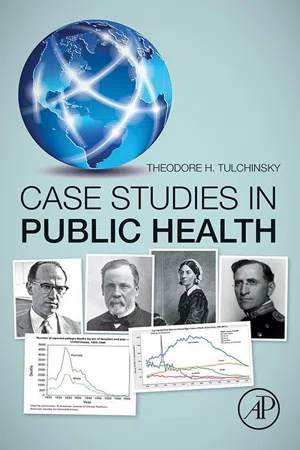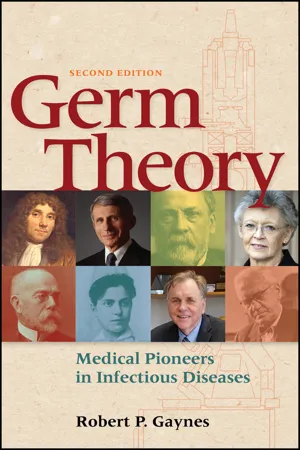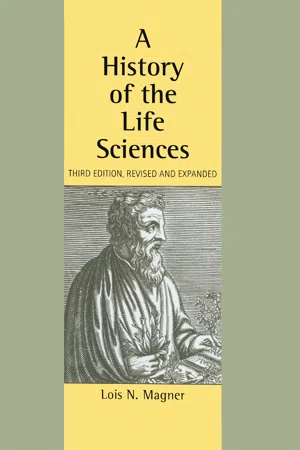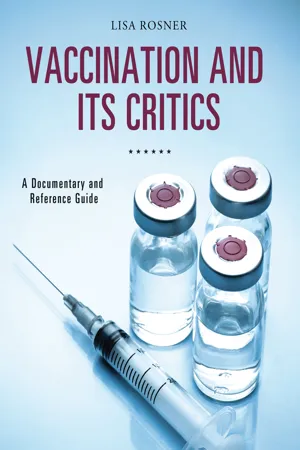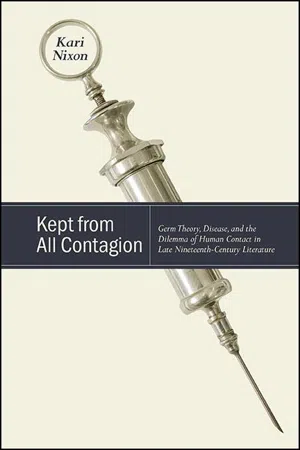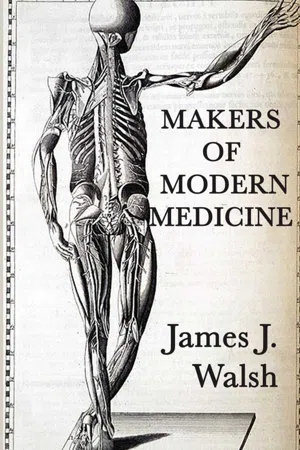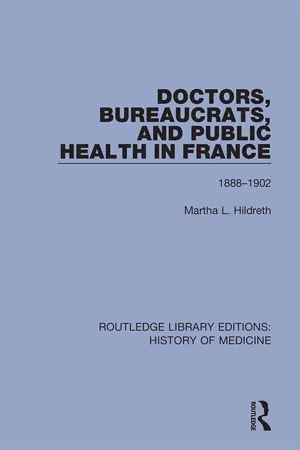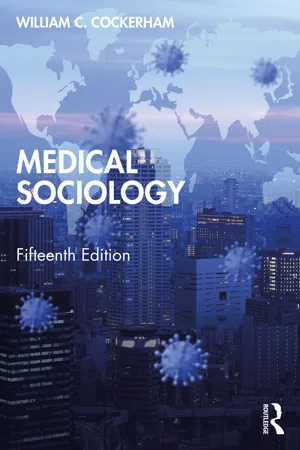History
Louis Pasteur Germ Theory
Louis Pasteur's Germ Theory revolutionized the understanding of infectious diseases by proposing that microorganisms, or germs, are the cause of many diseases. This theory laid the foundation for modern microbiology and led to significant advancements in public health and medicine. Pasteur's work also contributed to the development of vaccines and sterilization techniques, ultimately saving countless lives.
Written by Perlego with AI-assistance
Related key terms
11 Key excerpts on "Louis Pasteur Germ Theory"
- eBook - ePub
- Theodore H. Tulchinsky(Author)
- 2018(Publication Date)
- Academic Press(Publisher)
Pasteur succeeded in producing vaccines through attenuation, or weakening an organism’s strength aging of the organism in the culture media, as for chicken cholera vaccine, or by passing it successively through animals, recovering it, and retransmitting it to other animals. He postulated that if a vaccine can prevent smallpox, then one can be created for all diseases. In collaboration with a physician, he inoculated chickens with chicken cholera germs taken from an old culture. The dispute continued, however, with “germ theorists,” “miasmists,” or “sanitationists” arguing with equal vehemence.When Pasteur published the concept that the very microorganisms that contaminated the liquids also floated in the air, it was met with ridicule and rejected by the medical establishment. Pasteur’s monumental proof of the Germ Theory, over time drastically influenced the way in which public health evolved. He proved the existence of germs and their role in disease causation, confirming previous discoveries and promoting new scientific development in microbiology and immunology.While the Germ versus Miasma issue was debated until the end of the 19th century, the practical application of sanitary reform was promoted by both theories. Increasing attention to sewage, water safety, and removal of waste products by organized municipal activities was adopted in European and North American cities. The Sanitary Revolution proceeded while the debates raged and solid scientific proof of the Germ Theory accumulated, primarily in the 1880s. Fear of cholera stimulated New York City to establish a Board of Health in 1866. In the city of Hamburg, Germany, a Board of Health was established in 1892 only after a cholera epidemic attacked the city, while the neighboring town remained cholera-free because it had established a water-filtration plant.The specific causation of disease (Germ Theory) has been a vital part of the development of public health. The bacteriologic revolution led by the work of Louis Pasteur and his rival Robert Koch provided enormous benefit to medicine and public health. But those who argued that disease is environmental in origin (the Miasma Theory) also contributed to public health because of their recognition of the importance of social or other environmental factors, such as poor sanitation and housing conditions or nutritional status, all of which increase susceptibility to specific agents of disease, or the severity of disease. - eBook - ePub
Germ Theory
Medical Pioneers in Infectious Diseases
- Robert P. Gaynes(Author)
- 2023(Publication Date)
- ASM Press(Publisher)
Disease specificity, a concept crucial to the development of the germ theory of disease, was extended by early 19th‐century scientists. For example, Pierre‐Fidèle Bretonneau proposed a “morbid seed” causing specific diseases such as diphtheria in the 1820s. William Gerhard in the United States provided evidence that typhus was a distinct disease from typhoid, following an 1833 epidemic in Philadelphia. William Budd in England published a book on typhoid fever, stressing the specific and unchanging nature of the disease. Claude Bernard proposed that disease had a clinical spectrum; only the end stage was seen in hospitals. He emphasized experimental medicine where the laboratory, crucial for the germ theory, could be the seat for study of disease. While others had presented a concept that microscopic living organisms were the causative agents of diseases, especially those that occurred in epidemic form (1), it was Pasteur’s contributions to the germ theory of disease that ultimately led to its acceptance. A chapter on Louis Pasteur presents a considerable challenge. Louis Pasteur is probably the most notable nonphysician in the history of medicine (Fig. 9.1). Volumes have been written about Pasteur, including a biography from his son‐in‐law (2). Even with all that has been already written, his importance in the development of the germ theory of disease is crucial to include and still can present a few surprises to the reader. Pasteur researched the structure of chemical crystals and described the biological basis of fermentation of wine and beer. He debunked the widely accepted concept of spontaneous generation. Pasteur solved the mysteries of silkworm diseases, chicken cholera, anthrax, and rabies, which contributed to the development of the first vaccines with attenuated microorganisms. These seemingly unrelated topics can be strung together in a surprisingly logical sequence through Pasteur’s life - eBook - ePub
Great Feuds in Medicine
Ten of the Liveliest Disputes Ever
- Hal Hellman(Author)
- 2007(Publication Date)
- Trade Paper Press(Publisher)
Ever since 1857, when Pasteur had published his first paper on fermentation, he had been playing with the idea that there is a connection between germs and disease. His work with the diseases in silkworms pushed him even further in this direction. He worked continually to spread his germ theory of disease—but with little success.For example, one day in the late 1870s a famous physician was holding forth at the Academy of Medicine in Paris. Using lots of Greek and Latin terminology, he was explaining childbed fever as some sort of metabolic disorder.Suddenly a voice bellowed from the rear of the hall: “The thing that kills women with childbed fever—it isn’t anything like that! It is you doctors who carry deadly microbes from sick women to healthy ones . . . !”27 The voice was Pasteur’s, and he was again embroiled in one of his many celebrated battles.For despite the solid insights of Semmelweis, set forth a quarter of a century earlier (chapter 3), the medical establishment still refused to accept contagion as the disease’s cause. Pasteur, however, had something that Semmelweis did not, a mechanism to explain what was happening.The idea behind his germ theory seems simple enough today. Microorganisms such as bacteria, fungi, and protozoan parasites come from forebears of the same species; they are present in large numbers almost everywhere—in air, in water, in dust; finally, germs can therefore be understood as the causative factor in not only fermentation and putrescence but also in disease. Different diseases are caused by different microbes. It all fits together into such a neat package that it’s hard at first to understand why his germ theory was so controversial and took so long to be accepted.Recall, however, how difficult it had been earlier, and still was in Pasteur’s day, to combat vitalistic beliefs in the essential difference between living material and inanimate matter. There was still enough confusion that his ideas could be conflated with vitalism, and were sometimes used by its proponents to support their position. To Pasteur’s opponents, appealing to a living “germ” to explain a chemical reaction was a step backward. - Lois N. Magner(Author)
- 2002(Publication Date)
- CRC Press(Publisher)
Using Schwann’s metabolic theory of the cell as a point of departure, Henle compared the action of contagion to fermentation. Well aware of the difficulties confronting the contagion theory of disease, Henle warned that finding some microorganism in the sick did not prove that it had a causal role. The agent must be isolated and cultured so that it was free from any toxins or tissues of the diseased individual. Indeed, Henle came close to outlining what are usually called “Koch’s postulates.” Acknowledging the lack of rigorous evidence for the germ theory of disease, Henle argued that science should not wait for unequivocal proofs because scientists could only conduct research “in the light of a reasonable theory.” A major problem in establishing the truth of germ theory was methodological. Obtaining pure cultures was a difficult and tedious procedure, almost impossible in the hands of any but the most meticulous experimentalists. Working out proper sterilization and culture procedures required a prior understanding of and commitment to the germ theory of disease. Given the state of the methods available until quite late in the nineteenth century, it was no wonder new animalcules seemed to appear spontaneously in the tempt-ing broths set out for them, as well as in the raw wounds of surgical patients. Confused by the claims of the heterogenesists, physicians tended to reject the germ theory or dismiss it as a laboratory curiosity unrelated to clinical medicine. But as Pasteur’s associate émile Duclaux declared: “The great merit of a new theory is not to be true, because there is no such thing as a true theory, but to be fruitful.”Research on crystals led Pasteur to investigate the nature of fermentation and the diseases of wine, beer, and vinegar. His next practical challenge was a mysterious disease threatening the silk industry of France, causing great despair and hardship in many households and villages. Although Pasteur knew very little about silkworms and their diseases, he expected to resolve the problem by finding a germ. The problem was more complex than expected, because it involved two different disease organisms, as well as nutritional and environmental effects. The epidemic was actually the result of complex interactions among host, germ, and environment. From silkworm diseases, Pasteur progressed to the riddle of disease in higher animals and, finally, to rabies in humans. During this phase of his career, Pasteur was devastated by the deaths of two of his daughters, his son’s war experiences, and a series of strokes that left him partially paralyzed.Medical microbiology owes much to Pasteur’s studies of chicken cholera, a disease unrelated to human cholera, except in the virulence of the infection. Chickens that picked at foods soiled with the excreta of the sick acquired the disease. Based on reports by veterinary surgeons that bacteria were present in the tissues of sick chickens, Pasteur isolated a microbe that could be cultured in a medium made of chicken gristle. A small drop of the fresh culture would quickly kill a chicken, but the microbe only caused a small abscess in guinea pigs. Eventually, Pasteur discovered that it was possible to produce weaker cultures of the microbe, which could be used as vaccines. Laboratory-created attenuated cultures did not cause disease when injected into chickens, but these inoculated animals resisted infection when they were later challenged by virulent cultures of the microbe.- eBook - ePub
Vaccination and Its Critics
A Documentary and Reference Guide
- Lisa Rosner(Author)
- 2017(Publication Date)
- Greenwood(Publisher)
5
THE GERM THEORY AND VACCINATION (1870–1900)
THE GERM THEORY AND THE SCIENCE OF IMMUNOLOGY
- Document: Louis Pasteur, “Prevention of Rabies”
- Date: 1885, 1886
- Where: Paris, France
- Significance: Louis Pasteur, together with Robert Koch (see next section), was one of the founders of the germ theory, the theory that a specific microorganism causes a specific disease. He made bacteriology, the study of microorganisms, his life’s work. His research showed that an attenuated, or weakened, version of certain microorganisms could produce immunity to the disease in animals and inaugurated a worldwide effort to produce vaccines. In the section below, Pasteur explained the circumstances that led him to switch his efforts from producing immunity to rabies from dogs to people, specifically a nine-year-old boy, Joseph Meister (1876–1940).
DOCUMENT
Of twenty dogs treated, I could not render more than fifteen or sixteen refractory to rabies. Further, it was desirable, at the end of the treatment, to inoculate with a very virulent virus—a control virus—in order to confirm and reinforce the refractory condition. More than this, prudence demanded that the dogs should be kept under observation during a period longer than the period of incubation of the disease produced by the direct inoculation of this last virus. Therefore, in order to be quite sure that the refractory state had been produced, it was sometimes necessary to wait three or four months. The application of the method would have been very much limited by these troublesome conditions … - eBook - ePub
A New History of Vaccines for Infectious Diseases
Immunization - Chance and Necessity
- Anthony R. Rees(Author)
- 2022(Publication Date)
- Academic Press(Publisher)
Chapter 4: The biological origins of infection unveiled
Abstract
The displacement in the late 19th century of miasmatic theories of disease causation by living pathogens has been discussed. The development, stony passage, and eventual validation of Pasteur’s ‘Germ Theory’, evidenced by the development of immunity when anthrax bacteria that had been attenuated but still “live” were seen to prevent the disease. The revolutionary discovery that killed bacteria could also generate immunity, a fact that even Pasteur found unpalatable. The successful application of the attenuation methods used for anthrax to deal with the dangerous rabies infection at a time when viruses had not yet been discovered. The emergence of the great science of Robert Koch in Germany and his “Postulates” that defined the requirements for causation and his success in identifying the causative agent of tuberculosis has been discussed. Driven by a burning desire to find a cure, Koch drove down a blind alley with claims of a curative agent for the infection that would send his reputation spiraling down from its earlier imperious heights.Keywords
Anthrax vaccine; Four humors; Germ Theory; Koch Postulates; Louis Pasteur; Miasmatism; Rabies vaccineThe backcloth of early experimental observation
The notion that specific living entities such as pathogenic bacteria or other noxious living agents were the cause of infectious diseases was not “proven” until late in the 19th century and into the early years of the 20th century. As with the vaccine-antivaccine debate, “miasmatism” that assigned an inanimate origin to infections where the state of an individual's “humors” determined susceptibility and severity of any infection was a tough dogma to displace. First, any new explanation of disease had to provide evidence so overwhelming that experimental methods at the time might not enable such a high hurdle to be cleared. Second, the identification of something living (e.g., a microorganism) as a causative agent for infection should be shown to be both necessary and sufficient to generate that infection. Such causation criteria for proving scientific theories were well explored in the strongly represented German and English schools of philosophy by such intellectuals as David Hume, Immanuel Kant and in the second half of the 19th century by John Stuart Mill in his “Philosophy of Scientific Method.” It was into this hotbed of medical and philosophical dogma, where ambivalence over new, unproven theories coexisted with centuries old beliefs based on part science-part mysticism, that Robert Koch in Germany and Louis Pasteur in France leapt with revolutionary ideas that by many Church leaders and influential scientists and physicians were seen as dangerously iconoclastic. Their discoveries when exposed would rock the world of medicine and provide an understanding of disease causation that would confirm and complement the earlier work of Jenner on the efficacy of vaccines. As the discoveries of Pasteur and Koch unfolded their critics pointed to earlier discoveries that had preempted the concept that microorganisms are the cause of communicable diseases. The Italian physician Hieronymus Fracastori, whose 1546 paper was said to have made the first scientific statement on the nature of infection or contagion (he did not distinguish between the terms), described it as something that “passes from one thing to another.” He compared contagion to the emanations of an onion and although he used the term “seminaria,” or seeds, there was no suggestion from him that these “seeds” of disease were living organisms, described variously as “small imperceptible particles” that might be “hard” or “viscous.”1300 years later, Koch's mentor Jacob Henle was credited by some with the discoveries made by Pasteur and Koch. As the Italian-American medical historian, Arturo Castiglione, put it in 1941, Henle's essay published in 18402 - eBook - ePub
Kept from All Contagion
Germ Theory, Disease, and the Dilemma of Human Contact in Late Nineteenth-Century Literature
- Kari Nixon(Author)
- 2020(Publication Date)
- SUNY Press(Publisher)
Introduction “The Germ Theory Again”:Disease, Ideology, and the Possibilities of Biotic Life in the World of Antibiotic Purity Disease in the Community and the Self-at-RiskIn 1877, Chambers’s magazine published an article wryly titled “The Germ Theory Again.”1 Although the article contains simply an uncontroversial historical summary of the concept, its very title belies the author’s impatience with media saturation on the topic. Yet six years later in 1883, the London-based newspaper Good Words still found a demand for the topic, publishing a three-part series on germs titled “Microscopic Fungi” that eloquently reflects on the existential paradox of germs, those tiny “citadels of littleness” that wreak havoc on “person and estate.”2 The author empathizes with the presumed common attitude of his audience, agreeing “that it is hard to conceive how such immense capacity for evil gets stowed away in compass so small.”3 The tonal dissonance between these two publications highlights a key moment in history, in which I locate the goals of this project: the period between 1870 and 1900 when germ theory had “gone viral,” so to speak—saturating media discourse and reaching a wide audience of popular science readers who engaged with and understood the concepts it embodied—and yet simultaneously remaining mystifying and rather terrifying to the audience that consumed knowledge of it so readily.The growth, popularization, and prevalence of germ theory resituated the focus of scientific discourse on the humble microbe, and this conceptual priority in turn gave rise to the field of bacteriology at the end of the century. In a society just a decade beyond Darwin’s famous publications, the synthesis of these cosmological and methodological frameworks underscored for Victorians an invisible battle waging all around them: the intricate interplay between microbe and mankind. By the 1870s (and after a half-century of seismic scientific paradigm shifts), the unending struggle between these two classes of lifeforms for superiority and survival—even as they often inhabit the same interstitial tissues and cells—was an ever-present reality for the reading Victorian public. Epistemologically founded on Darwinian concepts of survival of the fittest, methodologically bolstered by the microscopic findings of bacteriology, and conceptually familiar since the 1860s because of the widespread publication of theories of germs and contagion, human experience of the Anthropocene was resituated during this period. The human stage itself was now set, in the popular imagination, against a backdrop of other microscopic lifeforms hovering within, between, and amid the human bodies that had only recently seemed to predominate on earth. Thus, indeed, could magazines within the same ten-year period express both exasperation with germ theory as an overdone topic and also fearful wonder at the “unseen mist of organic atoms” and the “manifold evils they have wrought.”4 Certainly, this Darwinian struggle performed the destabilization of the Anthropocene—if not to the naked eye, then at least in printed narrative. Indeed, “Bulk has ever impressed [humans] powerfully … but these microscopic specks … had not bulk enough to startle him.”5 Here, the author expresses the common Victorian wonder at the terror invoked by tiny organisms, which had the power to resituate humankind as only one of a handful of powerful classes of being, rather than its predominant force. The author tracks the development of germ theory with succinct anthropomorphism, noting that humans, “till of late, knowing nothing of their mystery … had no dread of them. Now [they are] beginning to Awaken to truth, and with wider knowledge there has come a terror of small things.”6 - eBook - ePub
- James J. Walsh(Author)
- 2012(Publication Date)
- Start Publishing LLC(Publisher)
His attention was next naturally directed to the diseases of animals and human beings. His studies in fermentations and in silkworm diseases had taught him the use of the microscope for such investigations. Splenic fever—known also as anthrax—a disease that attacks most species of domestic animals and may also prove fatal to man, was the first to yield the secret of its origin. The cause proved to be a bacterium—that is, a small, rod-shaped plant. This was but the first of a series of similar discoveries, until now the science of bacteriology has become one of the most important branches of knowledge. Pasteur’s investigations included much more, however, than the mere discovery of the germ of the disease. He showed that a series of diseases which passed under different names in different animals were all due to the same cause. Further, he discovered one of the methods of distributing the disease. When the carcasses of animals that have died from the disease are not buried deeply below the surface of the ground, animals grazing above may become infected with the disease. The germs of the disease can be shown to occur in the grass above the graves. It is carried to the surface in the bodies of earth-worms. This important observation was the first hint of the methods of disease distribution by some living intermediary. Modern medicine has come to understand that these biological distributing agents are far more important than the fabled transmission through the air.Pasteur overturned the notion of spontaneous generation of life. Then his work eradicated the idea of the spontaneous generation of disease. It opened up a new era by showing that the origin of many diseases is not due to changes in the atmosphere nor to some morbid productivity of soil or water under favoring circumstances, but to minute living organisms whose multiplication is encouraged by the conditions that were supposed to produce disease. Finally, came the precious suggestion that living things always convey and distribute disease; man to man, for epidemics travel not with the velocity of the wind but only as fast as the means of communication between distant points; animal to man, as is well known, for many diseases now; and, lastly, insects, worms and the like were also shown to be real carriers of disease. - eBook - ePub
- Roger Tim Haug(Author)
- 2019(Publication Date)
- CRC Press(Publisher)
Girolamo Fracastoro (circa 1477–1553) published a book on contagious diseases. He speculated that disease is caused by unknown and invisible “particles,” that the causative agents may be specific to a certain disease, and that the agents can be transmitted from person to person. Fracastoro’s speculations came close to the eventual solution, but it would be another 350 years before the germ theory of disease was scientifically proven. Most continued to believe that disease was caused by supernatural forces, bad vapors, or body imbalances. The death of George Washington, first President of the United States, is believed to have been hastened by the practice of bleeding a patient to correct a bodily imbalance.In 1840, the German pathologist Friedrich Jakob Henle (1809–1885) published thatthe disease inducer or causer reproduces itself in the sick body and at the end of the disease is eliminated from the body…In order to prove that they are really the causal material, it would be necessary to isolate (and culture) the contagious organism.However, Henle had no evidence to support this revolutionary concept and it remained only a speculation. Pure culturing was not possible in Henle’s time, but it would be achieved by one of his students, Robert Koch. With the culturing techniques developed by Koch and his students, the stage was set for one of mankind’s greatest advances, the germ theory of disease.In 1876, Robert Koch conclusively demonstrated that a given microorganism produces a given disease, i.e. the germ theory of disease. He demonstrated that Bacillus anthracis is the causative agent of anthrax, a disease then epidemic in sheep, cattle, and other domestic animals. Koch inoculated a series of mice with the bacillus, each time using the blood of the previous mouse. In each case, the bacillus grew in the blood of the newly infected mouse. Koch suggested that the animal’s death was due to a metabolic product (a toxin) produced by the bacillus.In 1884, Koch published what today are called Koch’s postulates . He described four experimental steps necessary to the determination of a causal agent for a specific disease.- 1. Find the suspected organism in all cases of the disease and demonstrate its absence in healthy individuals.
- 2. Isolate the organism in pure culture (very important).
- eBook - ePub
- Martha L. Hildreth(Author)
- 2018(Publication Date)
- Routledge(Publisher)
49In the 1880s, the popular medical journals still expressed considerable scepticism toward germ theory. Physicians continued to confuse contagion theory and miasmatic concepts of disease. 50 In the early 1880s, Dr. A. Bechamp of Lille promoted a theory of “Microzymas” which rivaled Pasteur’s microbe theory. Bechamp’s theory espoused spontaneous generation in a combination of germ and miasma theory. 51 In the 1890s, doctors writing for a popular audience still implicated air temperature and atmosphere as the main causes of cholera and flu. 52 Le Concours gave a great deal of publicity to Koch’s supposed development of an inoculation to treat tuberculosis, and when the technique subsequently proved useless, it became somewhat disenchanted, again, with germ theory. 53As the hygienists began to accept germ theory, they began to revive the once maligned theories of asepsis espoused by Joseph Lister in the 1860s. This was particularly true after the aseptic operation was performed in Germany in 1886. 54 It is difficult to know to what extent doctors in private practice were applying the principles of asepsis in the 1890s. Maurice de Fleury is probably a reliable witness on this issue because he was much admired by Cezilly and wrote generally in praise of the medical profession. 55 However, in 1890, Fleury had some critical comments to make about the inattention which doctors gave to contagion:“Doctors themselves are not what they should be. Dr. Maurice Letulle, speaking of the role of practicians in the face of infectious disease, demonstrates that the doctor himself is doubtless an agent of transmission of illnesses. He cites numerous cases and don’t we all know that the children of doctors themselves are frequently the victims of illnesses carried to them by their fathers? - eBook - ePub
- William Cockerham(Author)
- 2021(Publication Date)
- Routledge(Publisher)
Epidemics like the plague have existed for centuries, but the field of epidemiology did not develop as a form of systematic scientific investigation until the nineteenth century. It was not until 1854 that the work of John Snow established the foundation of modern epidemiology. Snow was an English physician who plotted the geographic locations of all reported cholera cases in London. He then went out into the neighborhoods of these victims and inquired into their day-to-day behavior. He wanted to know what they ate, what they drank, where they went, and the nature of all their activities. Eventually, Snow began to suspect that cholera was transmitted by water, since the common factor in the daily lives of the victims was getting their water from the Broad Street pump. At that time, London obtained drinking water from several water companies, and a few of these companies apparently were providing water contaminated with cholera bacteria. By closing down the pump on Broad Street, Snow was able to stop the epidemic. He not only established a mode of investigation but also demonstrated that research could lead to positive intervention and that social behavior and the physical environment were both important in the transmission of disease.At the time of Snow’s research, the development of scientific medicine was well under way. The work of Louis Pasteur and his immediate followers, during the latter part of the nineteenth century, revolutionized medical thought with the germ theory of disease stipulating that bacteria were the source of infection in the human body. The findings of Snow, Pasteur, and others provided the epidemiologist with a framework of analysis. Recognition that germs were causal agents of disease served as a precursor to scientific findings that people come into contact with a variety of causal agents. These agents can be (1) biological, such as bacteria, viruses, or insects; (2) nutritional, such as fats and carbohydrates as producers of cholesterol; (3) chemical, such as gases and toxic chemicals that pollute the air, water, and land; (4) physical, such as climate or vegetation; or (5) social, such as occupation, social class and class-based lifestyles, or location of residence.What a person does, who a person is, and where a person lives can specify what health hazards are most likely to exist in that individual’s life. The epidemiologist then identifies a particular host (person or group of persons or animals) most susceptible to these causal agents. Human hosts are examined in terms of characteristics that are both biological (age, sex, degree of immunity, and other physical attributes that promote resistance or susceptibility) and behavioral (habits, customs, and lifestyle). Next, the physical and social environment of the causal agent and the host is explored. The result is intended to be an identification of what
Learn about this page
Index pages curate the most relevant extracts from our library of academic textbooks. They’ve been created using an in-house natural language model (NLM), each adding context and meaning to key research topics.
